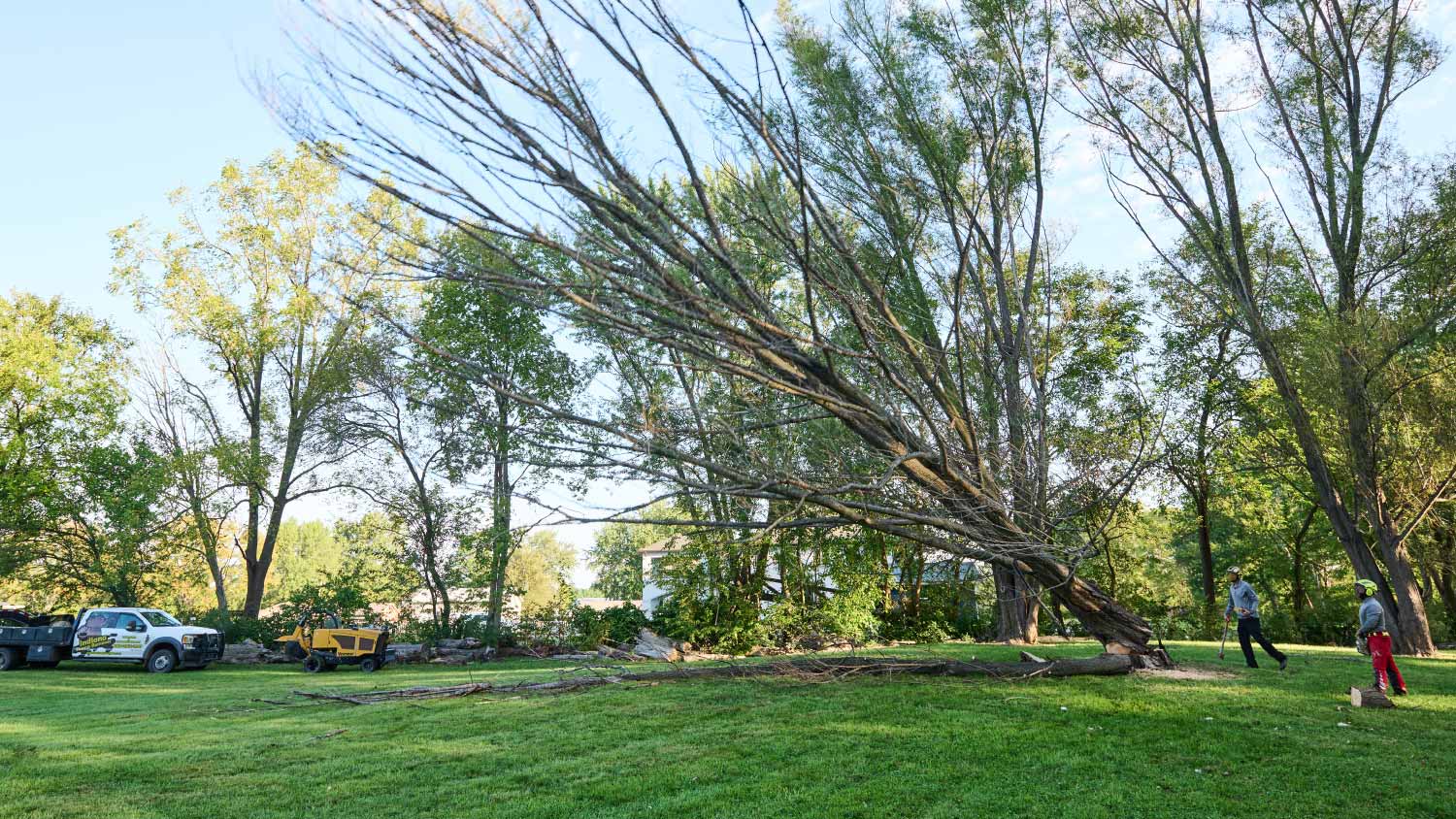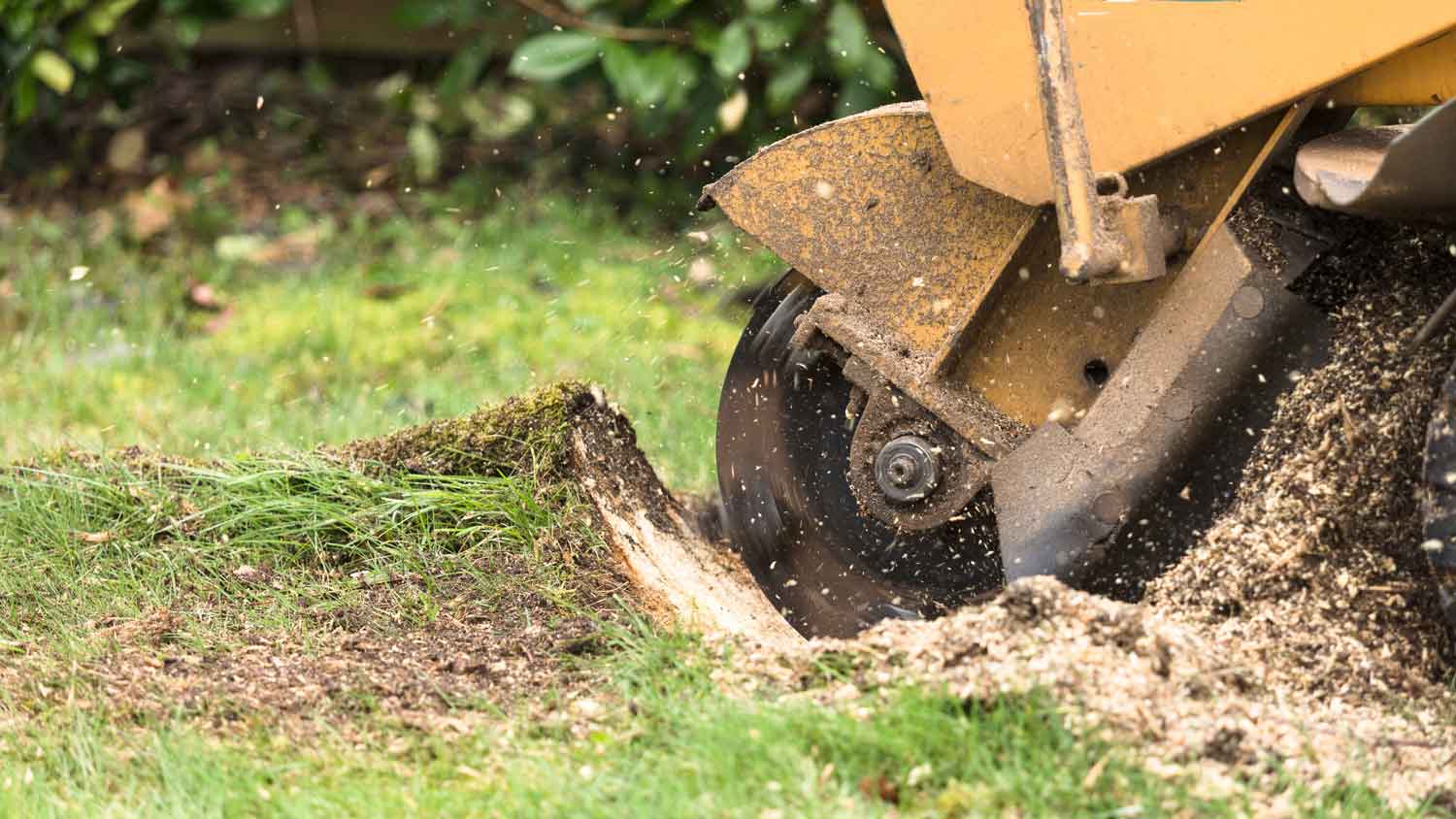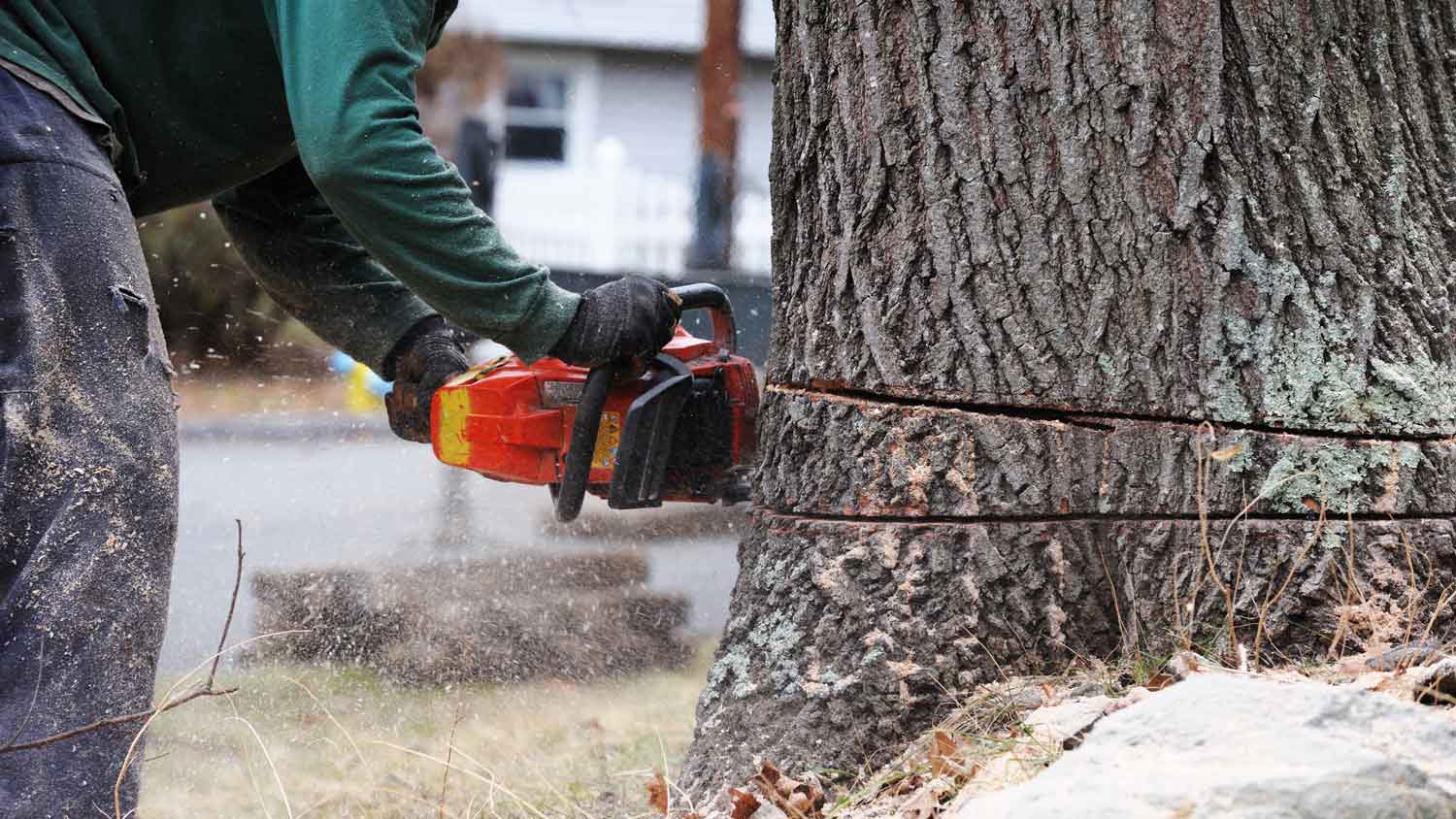How to Negotiate Tree Removal: How to Get the Best Deal
Negotiate tree removal like a pro


Tree removal costs $200 to $2,000 per tree, depending on its size, type, and location.
Get quotes from multiple companies to score the best deals.
You can negotiate tree removal costs by offering DIY clean-up and stump removal.
Book services in the winter off-season to lower costs.
Look into free tree removal through your city or local organizations.
While trees provide undeniable benefits, certain situations call for removal. From fallen trees to decaying trunks, it’s smart to know how to negotiate tree removal costs.
Removing trees is a big job, and if it’s unexpected (like after a storm), it can be a cost you weren’t quite prepared to spend. Fortunately, you can learn how to negotiate tree removal to save yourself some money while still getting the job done by a safe, reliable crew.
How to Negotiate Tree Removal Costs
Trees offer shade, natural beauty, and oxygen to their environments, but a bad storm, neglect, disease, tree fungus, and pests can leave them with dangling branches or unsafe trunks. Trees near your home or power lines on your property can also pose a danger, and you may need to remove a tree to keep your household safe.
Since this is a dangerous job that requires skill and precision, you shouldn’t attempt to tackle the tree removal process yourself. Try these tips and tricks to help you save money instead.
1. Consider Tree Value
Dead, damaged, or dying trees can pose serious hazards to your family and property, but healthy ones can be an important part of your neighborhood. Consider their value before planning tree removal services.
Will you miss the shade the trees provide come summer? Is it an old-growth tree that is an essential part of its environment? Take these factors into consideration before scheduling removal.
2. Do Your Research
It’s best to have everything you need ready when looking for company quotes. Research the types of trees and their estimated size, and also make sure to note their location on your property and how many you need removed before you start negotiations. Keep in mind that if they’re in difficult-to-access spots, it will cost more, even when negotiating.
3. Negotiate First, Not Last
Planning to clean up wood scraps or use them for firewood? Make that part of the conversation before signing the contract, rather than bringing it up after the tree has been cut down.
Negotiate first to get you and the tree removal company on the same page, and always get the agreed-upon price and discounts on paper to make the payment process straightforward.
4. Get Multiple Quotes
Before hiring a tree removal company, obtain a quote from at least three to five local companies. That way, you can get a better idea of the average cost of tree removal for your specific situation. If one quote is unusually low, you may not receive the highest quality of skill or service. On the other hand, if a quote is abnormally high, a company could be overcharging you.
Remember that price isn’t the only factor to consider when choosing a company for tree removal. When obtaining quotes, you can evaluate a company’s level of professionalism to avoid tree service scams. The quality of service they provide during the quoting process often will reflect their overall quality of service.
5. Ask About Discounts and Offers
When negotiating prices for tree removal, it never hurts to ask prospective companies about ways to lower cost. Some companies may run deals during slower months to generate business. Others may offer discounted rates when you bundle tree services, such as maintenance or removal of multiple trees.
Additionally, if you receive lower quotes from other companies, don’t hesitate to mention this during the negotiation. An interested company may match or even beat that price.
6. Set Up a Payment Plan
It’s no question that tree removal can be expensive. So, if your budget doesn’t allow you to pay for the cost of tree removal all at once, many companies offer financing by way of a payment plan.
Your removal company must partner with a third-party lender for this option. If your service qualifies for financing, you’ll be guided through an application process to determine your eligibility, loan amount, and terms. Once the application process is complete, you’ll pay off the service cost in monthly payments. Make sure to ask upfront about any interest rates or additional fees that may come with your financing option of choice.
7. Remove Multiple Trees at Once
When it comes to learning how to negotiate tree removal, the old saying, “The more, the merrier,” comes into play. You can often get a lower price if you remove multiple trees at once.
Maybe you’re clearing land to build a patio, or a pest has taken over the trees, bushes, and shrubs in your yard. A pro may be willing to reduce the price to take them all out in one (more affordable) visit.
8. DIY Cleanup and Stump Removal

Once the tree is down, you can save money by offering to clean up the debris yourself. Compare the cost of hauling it away on your own versus having the company do it for you. Renting tree-hauling equipment can be expensive, so you’ll want to do your research here.
Even if you don’t haul it away yourself, you can talk to the company about a discount for cleaning up remaining debris, like branches and leaves, yourself. You can also request that they chop the tree into firewood logs instead, which may also cut down on costs.
Hiring a local stump removal company costs about $100 to $150 for the first stump, plus $50 for each additional stump, and stump grinding costs about $170 to $500 per stump. If you have experience operating heavy machinery, you can remove the stump yourself to save money, but you’ll need to rent a grinder.
Another option is to leave the stump in your yard until you have a budget for grinding or removal. However, leftover stumps can be unsightly and will eventually rot, inviting pests to your yard, so this isn’t a great long-term solution.
9. Negotiate for Tree Removal With Neighbors
Whether you have trees along the property lines or your neighbor’s tree has branches leaning over into your yard, you can talk with your neighbors about splitting the cost of removal.
Be polite and understanding with neighbors who may not be thrilled about the idea of cutting down trees. But in some cases, this negotiation can benefit both parties by removing hazardous trees and saving money.
10. Look for Free Tree Removal Options

There are many ways you could end up getting your tree removed for free. Utility companies may offer free removal for trees that threaten power or sewer lines. Local governments can help you with removal of trees on city property (like if roots are destroying the sidewalk in front of your home).
Your local or state government may also provide grants or other financial assistance for removal, especially if you live in wildfire-prone areas or locations with extreme weather.
11. Hire a Local Company Instead of a Chain

With fewer executives up the chain of command, less office space, and generally less overhead costs, local companies may be able to offer lower rates than major chains. Plus, you can support your local economy by hiring a tree removal service in your area.
Just make sure the company is licensed, bonded, and insured before signing any contracts. Ask to see their contractor, city, and state licenses. Also, ask for their insurance company name and their agent, then contact the agent to verify insurance coverage before starting any work.
Average Cost of Tree Removal and Cost Factors

Tree removal costs an average of $750, but it depends on how many you want to remove, size, and how easy or difficult it is to access and cut them down. Here’s a look at what to expect when negotiating tree removal.
Size
Size is one of the most important factors in determining cost. You’ll spend about $8 per foot for smaller trees (30 feet tall or shorter) and over $15 per foot for trees over 30 feet tall. A wider diameter can also increase the cost of both tree and stump removal.
| Tree Size | Average Cost |
|---|---|
| Under 30 feet | $200 – $450 |
| 30 – 60 feet | $420 – $1,200 |
| 60 – 80 feet | $800 – $1,500 |
| 80 feet and up | $1,000 – $2,000 |
Type
The type can impact how easy or difficult it is to remove, which could increase the cost. For example, aspens are tall with deep, complex roots that are challenging to remove, making them more expensive than a small oak or ash.
Location
Taking out an old elm in a spacious, open backyard is easier and less expensive than removing an elm in a difficult location, like near a fence, against the house, or close to power lines.
Number of Trees
You’ll spend about $200 to $2,000 per tree for removal, but having multiple removed at once may earn you a better deal.
Emergency Services
Particularly after storms or other severe damage, you may need a tree gone—and quick. Expect to spend up to $5,000 per tree for emergency removal. The high price accounts for the even higher risk of injury for removal in these circumstances.
Cleanup
Companies charge about $70 to haul the tree away and about $95 to put it through a wood chipper. There may also be charges for debris cleanup to remove fallen twigs and branches in the yard after the work is done.
If you’re considering how to negotiate tree removal costs to save money, handling cleanup yourself is one of the top ways to reduce the project total.
Best Time of Year for Tree Removal Services
If you’re planning removal in advance, consider booking the service in early winter for the best deals. This time of year tends to be less busy for tree removal companies since people are spending less time outdoors, meaning you can score off-season discounts.
Don’t wait for it to get too cold or snowy, though, which could make removal more difficult and more expensive.
Choosing a Tree Removal Company

Now that you know how to negotiate tree removal, you can work on getting a fair price. But getting the best deal sometimes relies heavily on the company you decide to work with. But don’t just sign off on the lowest bid.
Make sure your tree removal company is licensed, bonded, and insured, and check for additional qualifications, like accreditations from organizations like the International Society of Arboriculture (ISA) or Tree Care Industry Association (TCIA).
You'll also want to check reviews and references to find a reputable tree removal company near you. Get quotes from at least three trusted companies to help you find the best bang for your buck.





- Tree Removal Process: A Complete Hiring Guide
- Can You Get A Tree Removed For Free? Not Usually
- Who Should I Call for Tree Branch Removal?
- How to Find a Good Tree Removal Service
- Who Should I Call When a Tree Falls in My Yard?
- Do Tree Removal Companies Need To Be Licensed?
- Stumped? What to Expect When You Need a Tree Removed in D.C.
- Who to Call if a Tree Falls on Your House
- How to Remove a Tree Yourself
- There’s a Tree on a Power Line: Who to Call to Remove It










